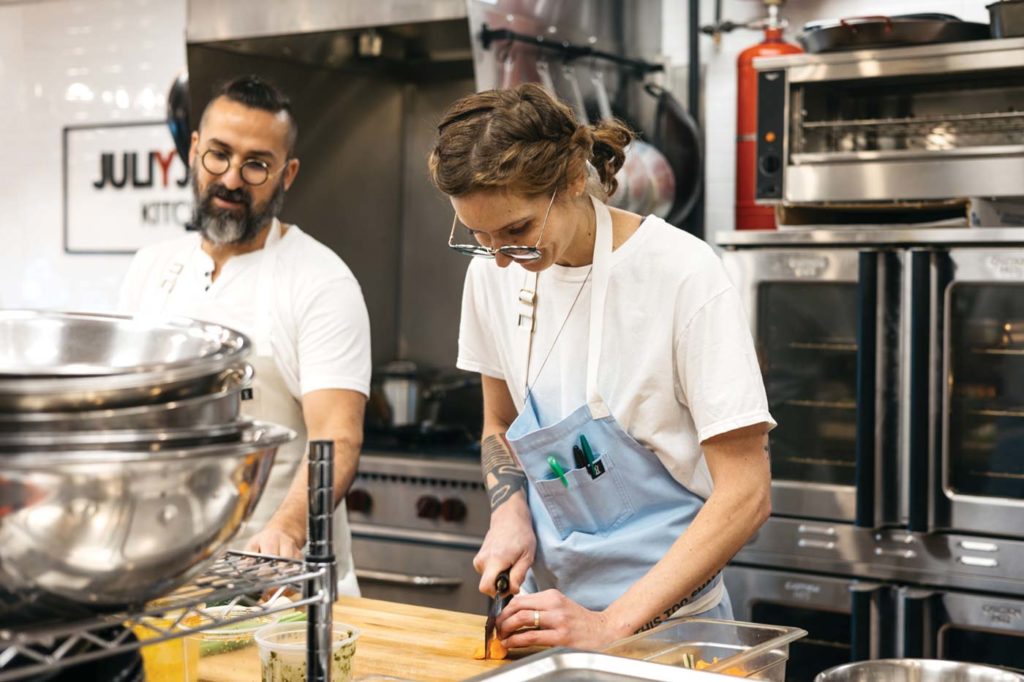The operational, financial and social innovations shaping the future of hospitality.
Since the first wave of Covid-related restaurant closures in March 2020, working in the hospitality industry has been a financial and emotional roller coaster. From investing in costly ventilation systems and PPE, to weighing profits against the safety of their teams, to pivoting from full-service to takeout-focused business models, we all can name best-in-class businesses that folded in the face of countless curveballs. Less visible, however, have been the stories of owners who have found a way to adapt under this pressure. Yet it’s precisely the approaches they’ve used to stay afloat that could shape the future of the restaurant industry as a whole.
Approaching the spring and summer of 2020, Juan Andres Rodriguez and Juliana Trujillo—the founders of Juli y Juan’s Kitchen in Fort Collins—had commitments to cater more than 80 individual weddings. By the end of the year, only four events came to fruition. “Financially, it was horrible,” Juli remembers. “Even though our contracts protected us, we didn’t want to take advantage of people. Instead, we rescheduled with everyone who still wanted to move forward.”
Delaying their profits indefinitely, the pair were required to furlough all staff, temporarily reducing their award-winning team to just the two namesake owners. Instead, with the help of an investment from Juan’s brother, they pivoted their attention to building a new kind of brick-and-mortar: “The commissary kitchens we worked in were never up to the standard we wanted, so we decided to build our own kitchen—one that could also cater to the community.”
Before signing a lease, the pair briefly considered working in ghost kitchens, but felt they weren’t suited for life behind the scenes. Similarly, taking on the overhead of a traditional restaurant space felt impractical—especially given their business’ ongoing catering commitments. Instead, they built a bright, immaculately clean kitchen space with a small storefront akin to a butcher shop or a bakery. “Our goal is to elevate the delivery service experience, rather than to mimic the model of restaurant takeout,” Juan notes. “It’s important to us that there’s still a sense of human interaction.”
Branded as a “delivery and pickup bistro,” this new version of Juli y Juan’s Kitchen has experimented with several different service models—from cooking both lunch and dinner, to reinventing the menu each week. The most recent iteration of the business focuses on dinner two nights a week and a menu that brings new flavor to such familiar dishes as roasted chicken or braised brisket. Each main is paired with one sauce and one side, while more adventurous guests can take advantage of the kitchen’s global-street-food-inspired appetizers and gorgeous homemade desserts.
Yet the details that make the difference aren’t just on the plate: Each takeout box is signed with words of gratitude from the team member preparing the dish—a personal touch that hasn’t gone unnoticed by Juan and Juli’s repeat customers.
In Denver, it was a loss of repeat customers and overall foot traffic that led restaurateur Tay Wilbanks to similarly reconsider her business model. Located on the border of downtown and the Golden Triangle, her bustling gastropub, The Greedy Hamster, had just celebrated its fifth anniversary in March 2020. Over the course of the following year, she watched as nearby hotels and offices remained stubbornly empty, despite rising commercial rents.
“It’s horrible to say, but it was cheaper for us to be closed than to only do takeout,” Tay recalls. “In a brick-and-mortar, unless you have a bar, it’s hard to support a kitchen. So if people aren’t coming into the bar, and you’re just doing to-go orders, the math isn’t going to work out.” Instead, Tay boldly pivoted to a takeout-only model by moving her business to ChefReady, a ghost kitchen complex just west of Platt Park.
With only a commercial kitchen to manage, Tay no longer worries about foot traffic. Instead, her team can focus exclusively on cooking delicious, delivery-ready food, which is then shuttled to a centralized pickup area coordinated by ChefReady employees. However, customer engagement still remains a primary concern: “You have to think of ways to push your business outside of face-to-face interaction. It’s a digital conversation—social media, email, text—with your customer that you never had before.”
The other significant shift for Tay’s team was evolving The Greedy Hamster’s menu, some of which was ill-suited for delivery. “You have one chance for the food to be hot, and it’s a single impression,” Tay emphasizes. “It could be a half hour before your food is delivered, so factoring in that time is very important.” For example, a beloved dish at the original restaurant was Black & Bleu Figs: caramelized prosciutto-wrapped figs stuffed with blue cheese. Another was the panko-crusted macaroni and cheese. The figs had to be scratched from the menu entirely, while the latter dish lost its signature topping.
On the upside, Tay has more information about her customers than ever before. With no complimentary drinks or dishes “on the house,” she has an absolute tally of what was ordered, by which customers, and how long it took to get there. As for new menu items, whereas it previously took her two to three months to gauge customers’ interest, she now receives that feedback in real time. “You can turn on a dime in a ghost kitchen,” Tay says. “Even if I have to close, I can communicate that immediately without canceling reservations or worrying about customers who might try to walk in that night.”
Despite this promising new business model, other restaurant professionals still find it hard to give up on the in-person interactions that drew them to working in hospitality. Such is the case for Chef Lisa Balcom and her husband, Patrick, the owners of Farow in Niwot. Opening in September 2021, the business evaded the pre-vaccine period of the pandemic, but it has since ridden subsequent waves of regional restrictions and general customer concern.
Back in 2020, both Lisa and Patrick were working at Blackbelly Market in Boulder, whose diversified business—butcher shop, restaurant, catering, takeout—was a helpful model for charting their own business plan. Yet ultimately, Farow was conceived as a traditional restaurant, with its owners betting on their customers’ desire for a certain experience. “We’re meant to be around each other,” Lisa reflects. “All this isolation has taken a toll on people’s mental and physical health, so we’re intentionally offering something that allows people to feel connected.”
It helps that Farow has opened in Niwot, a community that doesn’t see the rapid turnover of restaurants one finds in Boulder and Denver. Instead, opening something new is actually novel, providing a stronger opportunity for local engagement. In turn, Lisa and Patrick have gotten involved in parades and markets, hosted live jazz on their outdoor patio and even offered cocktail classes with their bartenders. They’ve further engaged customers by offering specialty items—like smoked Christmas hams or hard-to-find wines sourced by their talented sommelier—to customers at retail prices. On a more consistent basis, the restaurant also serves weekday breakfast for customers to grab en route to work or enjoy onsite.
“We focus not only on dinner service, which is the ‘cash cow’ for our business,” Lisa explains. “It’s also about the 10,000 little ways we can bring people in and offer value to our community. Some of these things don’t even require that much extra labor. You just have to market it, which is the biggest part.”
In creating that value-driven experience, it helps that Farow’s team has remained largely consistent since opening—a rarity in an industry facing unprecedented labor shortages. Yet even before the pandemic, Lisa and Patrick made strategic decisions that shaped the type of employees they could attract and retain over time: “We’ve both been in the industry for 20 years, and we’ve seen the full gamut of the good, the bad, the ugly. There’s a lot of improvement that can be made in how people are treated and how culture is built in a restaurant.”
At Farow, this philosophy takes shape in several ways. All full-time employees receive health benefits and, after the business has been open for one year, will get one week of paid time off, as well as staff bonuses derived from a profit-sharing model. The restaurant also forgoes tipping, opting for a 22% fair wage fee and an unconventional model for staff salaries: the more knowledge a team member has, the higher they are ranked in a point system. In short, this means that back-of-house workers can earn just as much as front-of-house, and that the development of new skills is matched with an increase in salary.
Fortunately, Lisa and Patrick aren’t the only business owners rethinking the human relationships at the heart of hospitality. For Juan and Juli, this question has shaped not only the open design of their kitchen space, but also how they perceive themselves as business owners. “[In the past two years], the restaurant industry has learned how fragile we are as businesses. We have to be mindful of, careful with, our resources—including people,” Juli emphasizes. “In a time of need, if you are not loyal to your staff, they will not be loyal to you.”
Since moving to the ghost kitchen, Tay may have less staff than before, but her takeaways from the pandemic still echo this sense of responsibility as an employer. “There was a huge mental health toll on small business owners as we weighed staying open with the safety of our teams. Not all restaurant owners are jerks. I paid phone bills, wrote letters to landlords … that responsibility to our staff continued even when our business was closed.”
This shift in the perception of employee rights, more so than supply chain concerns or overhead costs, may be the factor that most acutely shapes what food businesses will look like in the future. The pandemic has created a rare opportunity to take stock of the true human cost—mental, emotional and physical—of running a restaurant. With few industry professionals willing to return to the “status quo,” the salvation of restaurants lies entirely in owners’ appetite for reinvention.




